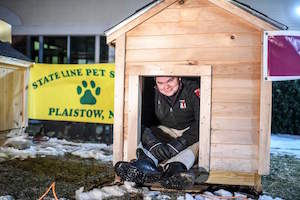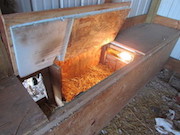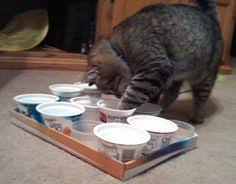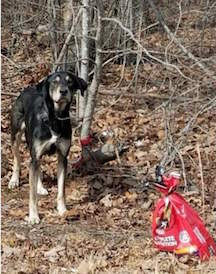Why Is Pentobarbital In Our Pet Food?
Jaclyn Bowen, Clean Label Project
 Jaclyn Bowen, the Director of the Clean Label Project, is back to explain why our pet's food supply is constantly jeopardized. You should listen before you shop for pet food again.
Jaclyn Bowen, the Director of the Clean Label Project, is back to explain why our pet's food supply is constantly jeopardized. You should listen before you shop for pet food again.
Jaclyn made us aware of a really big problem when they tested 99 pet foods and found everything from arsenic to heavy metals. Now, she has made us aware of the problem with pentobarbital that was found in pet food.
When you go to the store to buy pet food, you will find an amazing selection and variety. However, there is really only about three or four major brands. Unfortunately, they all source their food from the same places. You might remember the melamine pet food contamination and recall of 2007. Tens of thousands of animals ate the poisoned foods and many became sick, some fatally. Then it was pentobarbital, which is a euthanasia drug for animals, and no one knows how it ended up in pet food.
One possible way is through contaminated ingredients. The one thing that we could possibly see is that the ingredients came from a rendered animal facility, where essentially animals that had been euthanized ended up in the protein supply chain and were ultimately used in the creation of these finished products.
The J.M. Smucker company voluntarily withdrew shipments of several of its dog food brands where pentobarbital was found, including Gravy Train and Kibbles 'N Bits. This was only a small percentage of their overall portfolio of pet food brands.
These products are value priced products, so its one where just because something is value priced, doesn't necessarily mean lower ingredient quality. However, one thing that the Clean Label Project did identify is that Ol' Roy is the private label brand for Wal-Mart, so these products clearly shared the same ingredients.
Dr. Debbie explains that when we say pentobarbital, that doesn't tell us what kind of animal it came from. This is because it's a medication that is actually used to euthanize not just dogs and cats, but large animals that are not meant to be in the food animal world. So the presence of pentobarbital doesn't necessarily mean that it was a cat or dog that ended up in pet food. It just means there is an animal and we'd have to do DNA testing to find out just what kind of an animal it was.
This means the pentobarbital found in pet food could have come from a cow or pig, which is possible, but Jaclyn points out that when it comes to different euthanasia drugs, you would normally be looking at dogs or cats or even horses. Typically different types of stunning is used in the euthanasia farm animals and not a pentobarbital injection.
So are there any good foods out there? Jaclyn says that based on their testing, the Clean Label Project released a study where they tested nearly 1,100 of the best selling dry and wet dog food, cat food and treats in America. While you do see a significant quality gradient between the top and bottom performing products, there's a bunch of really great products out there for consumers that are looking for something that's both healthy and nutritious as well as low industrial environmental contaminants.
So how was the pentobarbital discovered in pet food? Were pets becoming sick and dying? Based on the investigation Jaclyn saw, as well as what Gravy Train has released, along with investigative reporter Lisa Fletcher, is that it was just through routine testing for pentobarbital.
The Clean Label Project has made consumers aware of contaminants in our pet food. Its no wonder people are leery about going into a store to buy food. However, the Clean Label Project has made it easier by maintaining a database of good foods and bad foods over at their website.
 Check out CleanLabelProject.org and look under pet food. They have a five star rating system where they basically are able to pull all of the different tests results across over 150 different industrial environmental contaminants and drill those down into an overall five star rating that you can check out on their website.
Check out CleanLabelProject.org and look under pet food. They have a five star rating system where they basically are able to pull all of the different tests results across over 150 different industrial environmental contaminants and drill those down into an overall five star rating that you can check out on their website.
To keep it fair and unbiased, the Clean Label Project does not accept money from any company. Jaclyn tells us that since they released the study, she definitely hasn't received any Christmas Cards from the pet food brands! Marketing departments do such an effective job at selling comfort and security, so for the Clean Label Project, it's all about exclusively using data and science to be able to see past all those claims.
So if your pet food is not on their list is there any way you can find out if it was contaminated with pentobarbital? Jaclyn explains that when it comes to pentobarbital, there were over a hundred products that were. So if you have any hesitation or any questions overall, she encourage consumers just to speak up and ask your brands for literally all details to substantiate any claims they have and specifically ask if their product has been tested for pentobarbital.
The Clean Label Project also has a certification program. It's for brands that are interested in getting certified and having the Clean Label Project Certification Logo on their package. To be a part of this, a company has to undergo unannounced testing. The Clean Label Project will then literally simulate the consumer shopping experience. They don't tell brands when or where, but they randomly pull products off store shelves and test them. These products then need to meet the strict requirements of the Clean Label Project Code of Practice. The only charges involved are for the actual testing. So far a handful of companies have come forward for testing.
Visit Website
Sleeping In The Doghouse
Ian Matheson, SPCA Stratham, New Hampshire
 Cold winters usually lead to the deaths of several dogs left outside in the elements. Ian Matheson wanted to do something about this so he spent the evening in the brutal cold weather to bring awareness to pet owners about the risks of leaving your dog outside overnight.
Cold winters usually lead to the deaths of several dogs left outside in the elements. Ian Matheson wanted to do something about this so he spent the evening in the brutal cold weather to bring awareness to pet owners about the risks of leaving your dog outside overnight.
Ian Matheson works for Field Services for the Society for the Prevention of Cruelty to Animals in Stratham, New Hampshire. He wanted to make a point to pet owners who leave their animals outside in the cold on winter nights, so he and Pelham Animal Control Officer Allison Caprigno decided to sleep outside in a doghouse to see just how cold it was. An emergency medical technician was on hand to make sure Ian and Officer Caprigno didn't suffer hypothermia.
In order to prove his point, this had to be done in the dead of winter. He tells us the temperature got down to 21 degrees that night. They were planning on doing this on an earlier date, but it turned out there was going to be a snowstorm so they postponed it. However, when they actually did sleep outside, there was still some snow on the ground.
The reason Ian did this is because he had seen a couple articles coming out from the Midwest about fatalities of dogs that had frozen inside of doghouses, especially the igloo types. You would think that if a dog were in a doghouse, they would be protected. This is also what Ian thought when he started out. However, a doghouse does provide protection from the wind, but they don't really retain body heat the best. Most doghouses are made of plywood and might even have some shingles on the roof. Per New Hampshire law, doghouses don't even have to have a door. The dog just enters, turns around and lies down and it has to retain their body heat, which most don't do.
 Ian tells us he and Officer Caprigno lasted five and a half hours. The deciding factor for them to quit was when Ian's feet were starting to freeze and the temperature was starting to drop. In fact, his body temperature was one degree lower than Officer Caprigno's. So they decided to call it.
Ian tells us he and Officer Caprigno lasted five and a half hours. The deciding factor for them to quit was when Ian's feet were starting to freeze and the temperature was starting to drop. In fact, his body temperature was one degree lower than Officer Caprigno's. So they decided to call it.
Most of us let our animals sleep in the bed with us, and if not, at least they sleep in the house. But if you do have a doghouse out back, insulation is key. If you can insulate your doghouse, that's the best thing you can do and put a flap on it for a door.
The most common insulator is straw or hay. However, some dogs will kick it out because they don't like it. So try giving them like a blanket to lie on or even a bed. Styrofoam is a good insulator as well, which is something that you can't recycle, so just keep a little for the doghouse. You could even put Styrofoam and hay on the walls, which would be a really great insulator.
Remember, if you are cold outside, your pets are cold too! So bring your animal inside or at least set a place up for them to sleep in the garage.
Visit Website
Stress-Related Feline UT's and UTI's
Dr. Tony Huffington
 Urinary Tract Infections are more common than you think. Did you know stress could cause a UTI in your cat or dog? Dr. Tony Buffington explains how a stressed animal is at higher risk for infection. Have you heard the Fear Free Pet Expert Series?
Urinary Tract Infections are more common than you think. Did you know stress could cause a UTI in your cat or dog? Dr. Tony Buffington explains how a stressed animal is at higher risk for infection. Have you heard the Fear Free Pet Expert Series?
Dr. Tony Buffington is an Emeritus Professor of Veterinary Clinical Sciences at the Ohio State University College of Veterinary Medicine. He is here to discuss Urinary Tract Diseases (UT's) and Urinary Tract Infections (UTI's) in felines.
Dr. Buffington explains that the two diseases are different and that urinary tract infections in cats are actually quite uncommon. However, the signs of a problem related to the bladder all look the same, because the cat pees blood, it pees outside the litter box, it sits in the box and screams, all those things. However, there are actually 30 different diseases that have been identified, which can cause these symptoms. They are not all equal and some are much more common than others.
In people, urinary tract infections are quite common and result in the same signs of pain and a constant need to go to the bathroom. The assumption is made that because the signs are the same the disease must be the same.
There is a link between stress and these issues in cats, according to Dr. Buffington, who spent his entire career learning about this. In the early 1990s, he received funding from the National Institutes of Health to study urinary tract problems in cats, as a naturally occurring model of a disease called interstitial societies in women, which is chronic pelvic pain syndrome. It turns out that as far as anyone can tell, it's the same disease in these two species.
 What they did with the studies is that they had people who were going to have these cats euthanized, because they were not acceptable pets to them anymore, donate them to his research colony. The things they noticed when they came in, was first of all they didn't just have lower urinary tract problems, many of them had problems with their lungs, their skin, their gastrointestinal tract or their behavior. And after they got into the enriched environment of the cattery they were kept in, all of their signs went away.
What they did with the studies is that they had people who were going to have these cats euthanized, because they were not acceptable pets to them anymore, donate them to his research colony. The things they noticed when they came in, was first of all they didn't just have lower urinary tract problems, many of them had problems with their lungs, their skin, their gastrointestinal tract or their behavior. And after they got into the enriched environment of the cattery they were kept in, all of their signs went away.
This started making it easier, because the only way that those organs can communicate with the environment is through the brain. So the brain had to be reading something in that environment that it found threatening for long enough that the organs started to function abnormally.
Stress, however, is the cause in about two thirds of the cases, which makes it the most common cause. People will notice that their cat is not using the litter box anymore, that they are hiding, or that when they pick up their cat, they'll try to bite them because their belly hurts. They may even go into the litter box 10 to 20 times a day instead of 2 to 3 times, which is normal. These would be signs that they're stressed.
So what can you do to lessen your pet's stress? Dr. Buffington states that the research done with cats points to changing their environment. When their environment changed, the animal got better. So he has a conversation with the owner to try to find out what's going on in the environment. For example, does the cat have a safe place where it can go? Is it being bothered by other cats or the dog? Does the cat have chances to climb and opportunities to scratch in places that are okay where the owner is not yelling at them or squirting water at them? So they restructure the environment and at the same time they try to talk to the owner and explain to them that cats are just a little bit different from other species. So if you put these things in the place and let them choose what they want to do, they often get better. For example, if we want to change the diet or change the litter, you don't just take the old diet or the old litter away and give them the new one, because the cat might not even know what it is. So you always change it by placing a separate container with the new items next to the usual one and let your cat chose.
 Dr. Buffington also explains that cats are hunters by nature. That's what they were put on this planet to do. Unfortunately, when they came into contact with us a few thousand years ago, we changed their lives. Now he is a big fan of putting their food in different kinds of food puzzles so that they have the opportunity to hunt and find their food.
Dr. Buffington also explains that cats are hunters by nature. That's what they were put on this planet to do. Unfortunately, when they came into contact with us a few thousand years ago, we changed their lives. Now he is a big fan of putting their food in different kinds of food puzzles so that they have the opportunity to hunt and find their food.
Doing these things really improves a cat's perception of control of their surroundings, because stress happens when you lose your perception of control.
Visit Fear Free Happy Homes for tips on making your home fear free and to locate a Fear Free Veterinarian near you. Go to Fear Free Pets to become certified.
Listen and Explore the Fear Free Expert Series
How to NOT Train a Dog - Dr. Debbie
 The other day I was walking my dog in a community area and encountered a lady with two Shih Tzus. As we approached, her dogs rallied with barking and tugging on their leashes. I asked if her dogs were friendly, so as to decide if we could approach. The lady scowled, embraced her still barking dogs and grumbled, "Do they look like they're friendly?"
The other day I was walking my dog in a community area and encountered a lady with two Shih Tzus. As we approached, her dogs rallied with barking and tugging on their leashes. I asked if her dogs were friendly, so as to decide if we could approach. The lady scowled, embraced her still barking dogs and grumbled, "Do they look like they're friendly?"
Realizing this dog owner was more unsociable than her dogs, I decided to vamoose, but not before I envisioned this blog topic - how pet owners mold unsocial dog behavior.
Unwanted doggie behavior such as lunging and barking on the leash become established when the dog owner hasn't made it clear what the appropriate behavior is, fails to correct and redirect to a more suitable behavior, or simply reinforces the undesirable behavior through actions or words. Face it - there aren't bad dogs, just poorly trained ones.
Avoid making these top 5 training mistakes:
1. Secluding Your Dog in the Backyard
Keeping your dog in lock down almost guarantees problem behaviors will develop such as biting, inter-dog aggression and phobias to anything from noises to car travel. Isolated dogs lack the experience and confidence when faced with novel situations while socialized dogs adapt easily.
I see it all the time - the dog owner prides herself in keeping her dog safe. "I didn't want Fido to catch any diseases as a pup, so I didn't let him out of our backyard till he was a year old." The overwhelming fear of infectious diseases like parvovirus causes some well-meaning owners to confine their new dog or puppy to the limits of house and yard. Even more extreme is never allowing a puppy to step foot outside until after their last puppy vaccinations! Puppies are most adaptable to new experiences between 6 and 16 weeks - this is the time to expose them to unfamiliar places, people and animals.
That doesn't mean you should take your eight week old puppy to dog parks, but rather to use good sense selecting low dog traffic areas and visiting with family and friends outside of the home that have properly vaccinated pets.
2. Skipping Obedience Training
Going to school is a must for any new dog to a home, whether a puppy or adult. No two dogs are the same, and each learns differently. Formal obedience training is a useful tool to gently reaffirm who's in charge and sets the rules in the house. Statistics show that dogs that go through formal obedience training are less apt to develop behavior problems and be relinquished to shelters.
 3. Reinforcing Fear at the Veterinary Office
3. Reinforcing Fear at the Veterinary Office
In the exam room I cringe when I see a dog owner comforting a nervous, fearful or aggressive pet. That "good boy" and pat on the head reinforces your dog's behavior, making it more likely that on the next hospital visits he'll behave the same, or worse. Some problem behaviors escalate making it difficult for the veterinary staff to examine or treat the animal. This may mean additional costs for sedation or anesthesia for routine medical needs.
It's natural for a pet owner to want to reassure a pet when he is frightened and it can be difficult to hold back the urge to soothe him. However, the best strategy is to ignore those fearful behaviors in the vet office. Don't be tempted to kiss, snuggle or hold Fido on your lap when he is misbehaving. Rather, place the dog on the floor, refocus your dog's attention to you, and cue him to "sit" or "lie down."
4. Not Using Food as a Reward
Food shouldn't just be for the taking. Don't leave food out for your dog to graze whenever he wants and don't give treats just for the sake of giving a treat. Present food and treats as a reward for good behavior such as sitting quietly, going to a pillow, or performing a trick or obedience work. This places you at the top of the household hierarchy. You become the provider of great edibles in the house, and your dog will be motivated to listen to your requests in other situations.
We all love to spoil our dogs and give treats at times. But be sure to give treats for a reason, or you will have a spoiled doggie brat on your hands.
5. Not Exercising Your Pet Enough
Inadequate exercise can result in obesity and boredom, and may lead to problem behaviors like separation anxiety, destructive chewing and excessive barking. Dogs should get 30 to 60 minutes of sustained physical activity each day for optimum mental and physical benefit. And no - letting Buffy run around the backyard during the day is not adequate exercise.
Not all breeds are cut out for all exercise - a Labrador may enjoy retrieving games or swimming, a Jack Russell terrier may thrive with jogging or Frisbee, while a Basset hound will be satisfied with a leash walk.
Your dog can't be a well-adjusted, socialized canine citizen without you, as the pet owner, taking an active role in training. Put the time in, and you'll be thanked many times over with an outgoing, friendly canine pal that can accompany you on life's adventures.
Featured veterinarian known as "Dr. Debbie" on national pet radio program, Animal Radio. Ebook author of "Yorkshire Terriers: How to Be Your Dog's Best Friend"; "Pugs: How to Be Your Dog's Best Friend"; "Mini Schnauzers: How to Be Your Dog's Best Friend"; and "Shih Tzu: How to Be Your Dog's Best Friend." Dr. Debbie's books.
Visit Website
Animal Radio News - Lori Brooks
 Dog Tests Positive For Rabies After Biting Owners
Dog Tests Positive For Rabies After Biting Owners
A family dog in Delaware tested positive for rabies after biting his two adult owners. The owners were bitten while attempting to put the dog in a kennel when the dog became aggressive. Apparently, when the dog was outside he was not supervised and not on a leash. Their yard is not fenced, so it's pretty much impossible to know how the dog became infected with rabies. The dog was also not up to date on shots. The adults, who were bitten by the dog, went through rabies treatment. Rabies is an infectious disease affecting the nervous system of humans and other mammals. Infection happens through the bite or scratch of an infected animal or if saliva from an infected animal gets into the eyes, nose, mouth, or an opening in the skin of the bite victim.
Preferring Pets Over Partners
The results of a survey showed that more than a third of us actually preferred being with our pets as opposed to our partners. A study of 2,000 cat and dog owners showed more than half often preferred spending time with their pet. This is because our pets love unconditionally, they don't nag, they never talk back and are always in a good mood. Three in 10 adults said their pet is a better listener than their partner, while 45-percent liked the fact they are never judged or questioned by their cat or dog. Surprisingly, 29-percent even said their four-legged friend was better at snuggling and as such 44-percent actually preferred to cuddle up with them rather than their other half. More than four in 10 pet owners admitted to giving their beloved dog or cat far more attention on a daily basis than their significant other. And whereas the partner is relegated to the other side of the bed most nights, the dog or cat wasn't pushed away if they turned up for a snuggle. Also, when faced with the decision to choose a pet or a partner, 14-percent would rather spend the rest of their life with their pet.
 Because We All Love Happy Endings
Because We All Love Happy Endings
An abandoned dog tied to a tree in the woods of Virginia found its forever home thanks to the Prince George County Animal Shelter. Zeus was abandoned by his owner who left a note attached to his collar saying she couldn't afford to care for him any longer. Also found near where Zeus was discovered was a half eaten bag of dog food. The shelter believes it rescued Zeus on the same day he was left in the woods, because it was a rainy day and the bag of food was still dry. Zeus, who is a two-year-old German Shepherd-Labrador Retriever mix and his sad story got a lot of attention, which is probably what landed him a new home. The shelter posted an update on its Facebook page that Zeus had found his forever home and urged pet parents who are unable to care for their pets to please reach out to their local shelter or rescue.
Merging Pet Households
As more and more people with multiple pets are getting together, dating or moving in together, everyone needs to be aware of how to introduce pets properly. Experts says just like when your pet first met your new significant other, plan to make the pets meet and greet on neutral territory, which is much easier to do with dogs than cats. With dogs you can easily take them for a walk together. But, two of the biggest issues that arise when merging pet households include making sure everyone is on the same pet parenting page and making sure all the animals get along before moving in. Perhaps the biggest challenge is when one pet is moving into another pet's house. If so, try to manage the dynamic so that at least for the first few weeks, the pet who lived there first gets the majority of the space and don't move their toys, food bowls or bedding until the adjustment period is over. Ideally, you should create a space for each pet. Usually, if two people are going into the relationship and each has cats, you can expect to keep the cats separated for longer than you might with dogs. There is no magic number of days or weeks. Just make sure you know the signs of potential conflict. For dogs, look for tail lowering, lip licking, head-turning away and cowering. And for cats, if you see a fight brewing between them, separate them before it gets out of hand.
 Innocent Man Left Prison and Reunited With "Innocent"
Innocent Man Left Prison and Reunited With "Innocent"
Malcolm Alexander spent nearly four decades in prison for a crime he didn't commit. Fortunately, the Innocence Project worked on his case and got the proof needed to prove his innocence, but only after Mr. Alexander had spent 38 years behind bars. However, when he left prison, he was not alone. A day after he was freed, he reunited with the dog he'd raised behind bars. The 9-month-old pup's was named Innocent or Inn for short. As a well-behaved inmate, Mr. Alexander was allowed to have Innocent as his companion animal as part of a special program, which allowed the dog to go to his prison worksites with him.
 Listen to the entire Podcast of this show (#1158)
Listen to the entire Podcast of this show (#1158)





